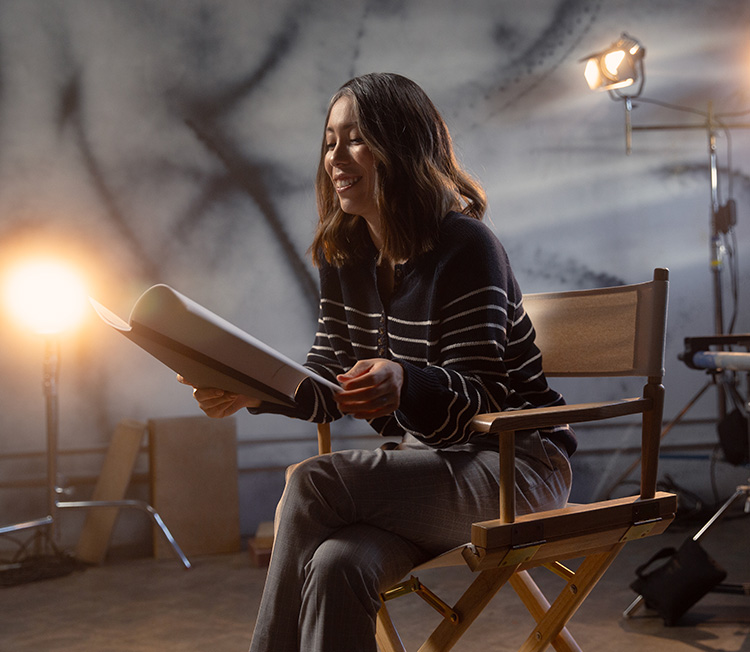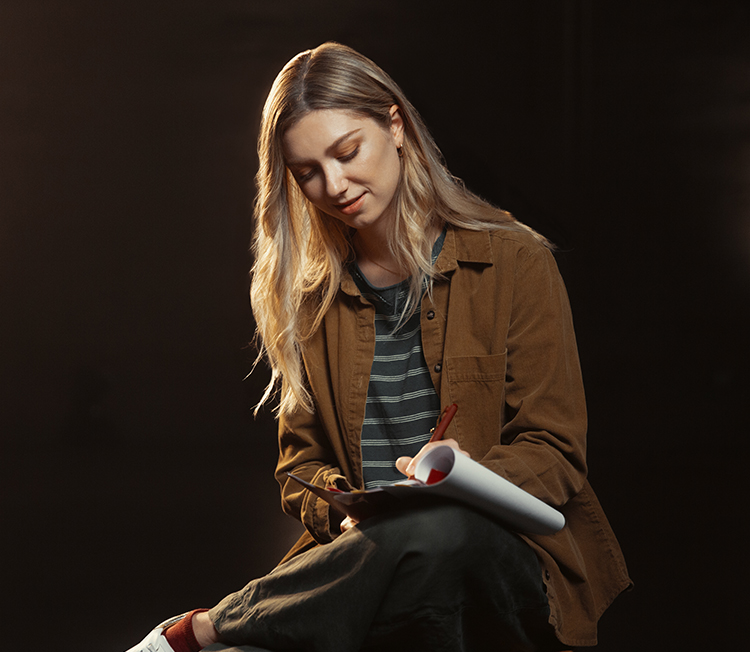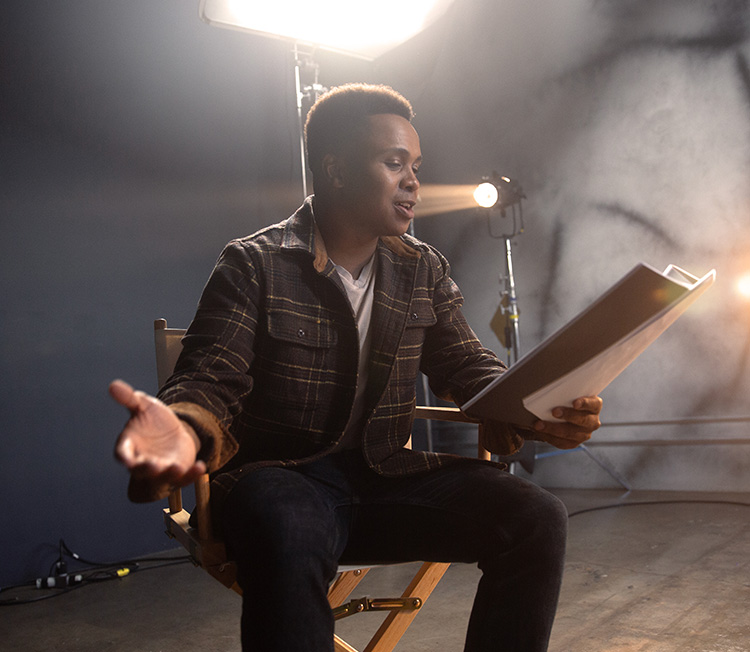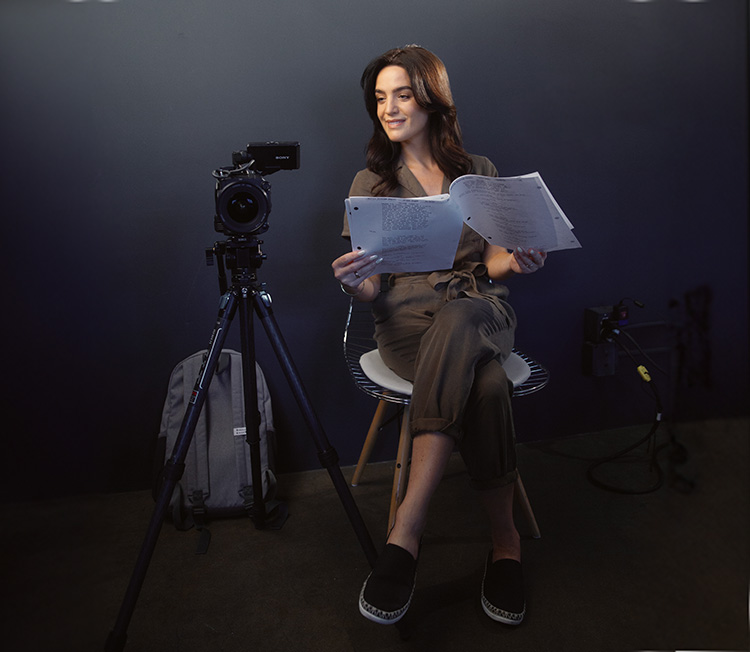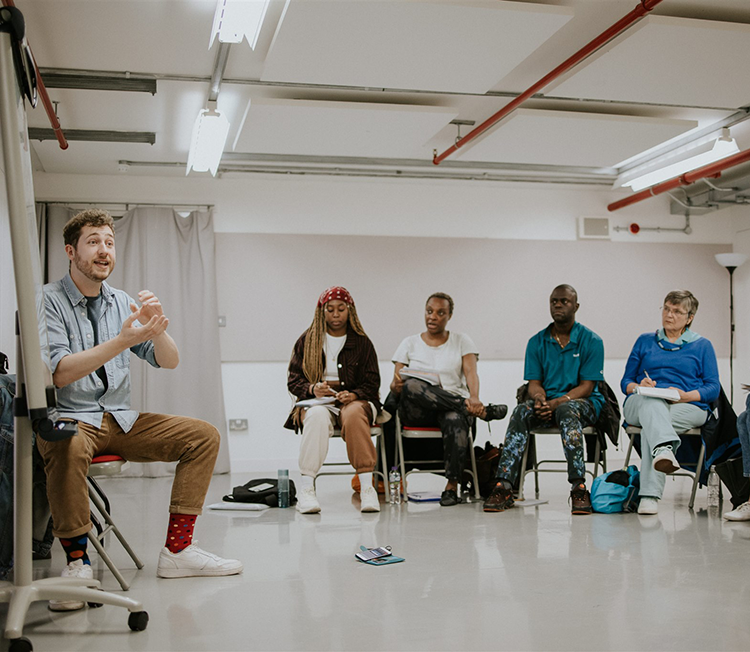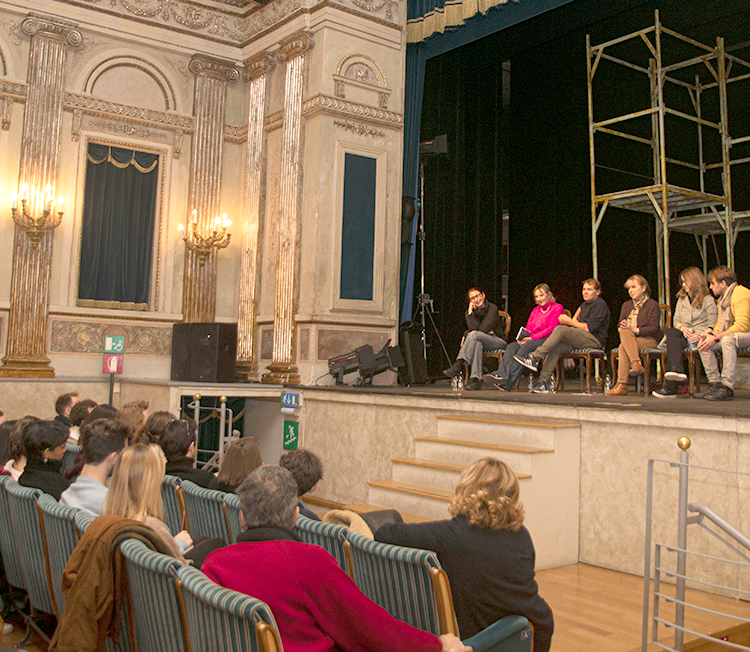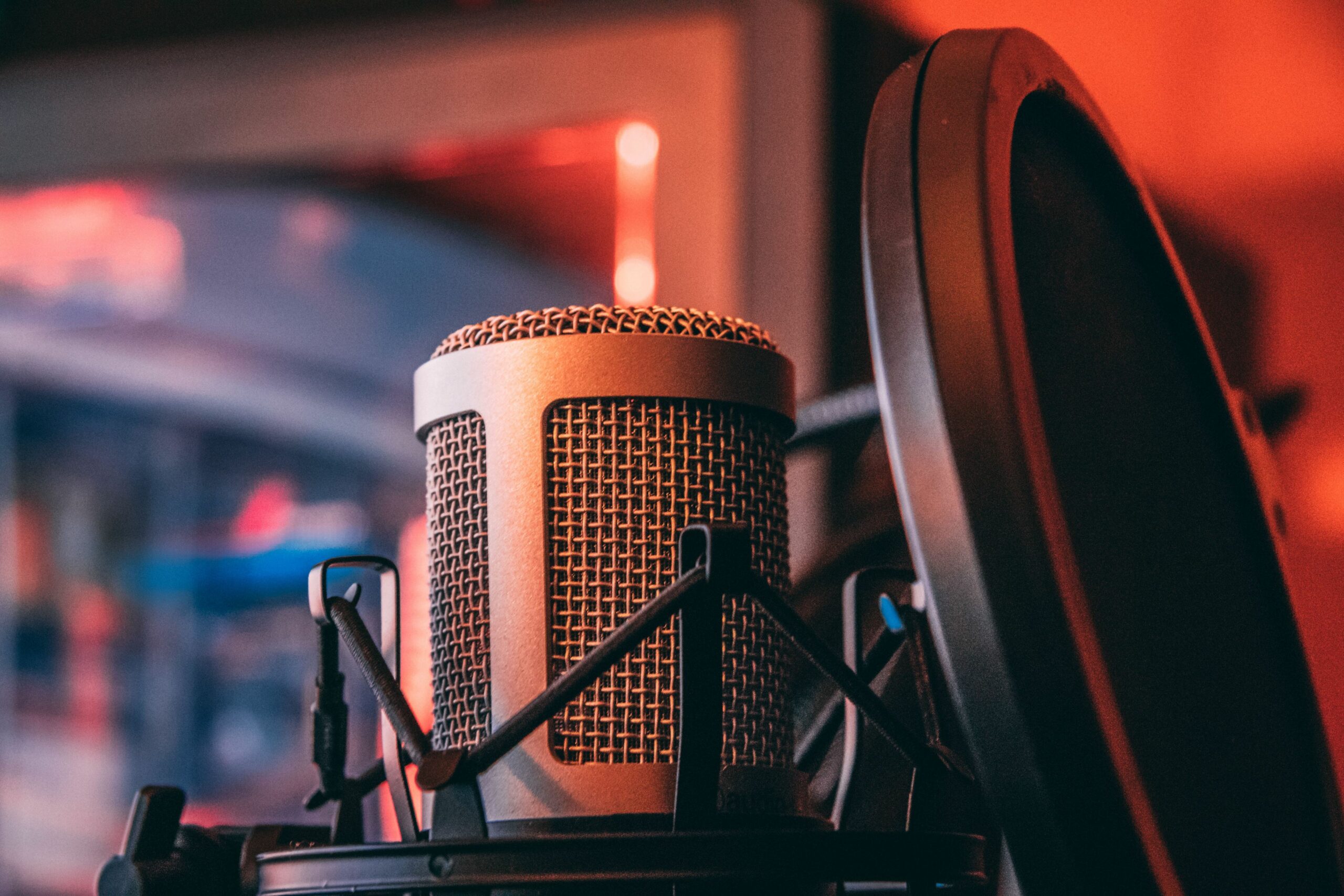Practical exercises from Nina Zendejas, Head of Voice at Italia Conti (MT), for practising character voices, Received Pronunciation and General American accents.
In this episode of The Spotlight Podcast we talk to Nina Zendejas, an international voice coach specialising in accent and dialect, and native to the United States. Currently working as the Head of Voice at Italia Conti Academy of Theatre Arts (MT) in London, she is also a voice over artist and freelance production coach.
Nina talks to us all about experimenting and creating characters with your voice, dealing with accent changes for auditions, improving your Received Pronunciation (RP) and General American (GA) accents, and how to get the most out of your voice long term.
It’s a super fun and practical episode with a lot of great information and some exercises you can try yourself at home.
51 minute listen.
Full transcript below.
Take a look at more great advice on voice work. If you have a topic or question you’d like us to cover in a future podcast episode then please email your ideas to questions@spotlight.com or send us a Tweet @spotlightuk.
Episode Transcript
Christina Care: Hello, and welcome to The Spotlight Podcast. My name is Christina Care. I’m the content manager at Spotlight and today we are talking all things voice work and accent work with Nina Zendejas. Nina is just a really joyful person who works in voice, as you’ll hear shortly. She’s currently the head of voice at Italia Conti Academy of Theatre Arts in London, and she’s also a voice over artist in her own right and a freelance production coach. She’s worked all across the UK and the US, and we’re going to talk all about getting into character with your voice, managing accents, and how to switch between accents quickly, amongst lots of other things, so take a listen. Nina, thank you so much for joining us on The Spotlight Podcast.
Nina Zendejas: Thank you so much for having me.
Christina Care: It’s been quite a marathon day for you here at Spotlight.
Nina Zendejas: Yes, it has.
Christina Care: You’ve held a few sessions with us as part of our open house on character voices, and then you just did a session on English as a second language and moving into RP.
Nina Zendejas: Yes.
Christina Care: And you’re doing a session on General American tomorrow. This is kind of the context that we’re in. This is why you’ve come in today. I kind of want to start though by asking you about voice work. Were you the kid in school who just mimicked cartoons or something like, how did you get into voice work in the first place?
Nina Zendejas: I think, as I said in the character voice workshop, I was 100% that kid. I started off being nerd choir kid, and I went eventually into musical theatre actually. But as a younger kid moving into sort of young adulthood, I was pretty obsessed with cartoons and I would always sit around and be the weird person that didn’t mind about making strange sounds in their bedroom. I’m pretty sure my parents thought strange things, but here we are today, so it worked out in the end. I think it’s just important to remember, to always keep playing because kids just have that freedom, don’t they?
Christina Care: Yeah.
Nina Zendejas: And we do too, if we give ourselves the chance, and it really makes a difference, especially when you’re attempting to do anything more advanced than sort of authentically represent yourself. When you have to go into extremes and be versatile, it really makes a big difference. That sort of mental freedom.
Christina Care: Absolutely. You mentioned doing a dissertation, in fact, in character voice.
Nina Zendejas: I did.
Christina Care: Yes. I want to ask you, how did you train, like how did you gain the skills that you have now in voice work?
Nina Zendejas: Right. First of all, I first went into opera. I did one year, and then I quickly realised I wasn’t in love with opera, but I was in love with singing in general because I did 12 years of sort of choir. Then I did a one year of opera, switched to musical theatre. That wasn’t as easy as I made it just sound, but I did eventually switch into musical theatre, and I attended the Boston Conservatory in Boston, so I did a bachelor of fine arts there. Then through those four years, we always did voice and speech. We did a four year progression of that, and I was interested in that work in particular. At first, I was that person that was really not very into it. I think I remember being semi-furious at one point, and then I was kind of in love with it, and then you couldn’t separate me.
I actually invented my own emphasis in senior year, which was allowed. We did like acting emphasis or singing. We basically spent longer on topics we loved or things that we thought we’d take forward. I kind of invented one because that was an option. I did a lot of show coaching, a lot of work with student productions and the main stage productions. Eventually, after all that, after my showcase, I also found out I got into The Central School of Speech and Drama, now The Royal School of Speech and drama, that’s fun, and I did my masters there. I graduated in 2012 from that one. I decided to go back for my MFA because they … I was part of that unfortunate group that … it’s so boring, but I was basically just part of the group that missed out on the F, the MFA, I did it after it.
Because I’m American, that made a difference so I did it. My first dissertation was on puppetry, because I worked with the puppeteers who have an actual bachelor’s degree at central, and I was placed with them, and their first request was we really need a way to safely do character voice work. I thought to myself, okay, that sounds amazing. I love this, but also, how do I get you from A to Z without completely … Well, they didn’t have very much voice training, meaning they had none.
Christina Care: Right, because they’re all puppeteers.
Nina Zendejas: Right. You would think though, as puppeteers, considering a lot of times they’d have to maybe do, I don’t know, eight voices at a time, and eight distinct voices quickly while moving behind a set, while shoving their hands into puppets, I presume, or doing some other form of puppetry, they had to do some really seriously difficult work. I went into kind of the London puppetry scene for a while and I investigated what was happening. I went to a few of their Q&A sessions with some of their theatres, and it was really, really cool, but I eventually kind of developed a sort of method. It was experimental, and I brought some of that earlier work into today as well, but I’ve developed it since then.
Christina Care: Right. Just to hone in on that a little further, when it comes to actually starting with creating that character, I think you mentioned a lot about kind of just listening and mimicking as a starting point, but then it can’t just sort of stay there. Can you take us into that process if someone wants to start creating their own characters, or they’re interested in that kind of voice work, where do they begin?
Nina Zendejas: Right. It depends on the person. Some people work really well with mimicking. Some people, if I said that to them, they’d be like, well, I just shut down because I’ve tried to do that my whole life and I’ve had no success from that. There’s kind of two ways to approach it. You could listen to awesome, amazing cartoons and artists that you love, voice artists, and you can be like, okay, I’m just going to take all of my who cares out of the window and I’m just going to go for it, and I’m just going to, in my private space, I’m going to make crazy sounds, I’m going to feel like an idiot, but it’s going to be magical, and that’s kind of half of the journey. You could do with friends, which would be even better.
If you want to do it alone, I’d understand. The other way is you go, okay, I literally can’t mimic. For whatever reason, you’ve blocked yourself or it’s not something you ever developed young. Maybe it might be better for you to actually start with a few of the techniques I kind of did today, which was, for example, you could start by accessing different parts of your speech. You could go extra nasal or almost aggressively de-nasal. This requires a bit of knowledge though of the anatomy, but honestly, you could just pull up like an example of the face, a sideways profile of the face, the anatomy of the face point to a part of you like your jaw or your nose or your lips, and you could say, you know what? I’m going to almost aggressively activate this area.
I don’t know what that means, but I’m going to have to play. But I think the main thing is you just kind of have to be willing to play.
Christina Care: Right. You have to try it.
Nina Zendejas: You do. At first, you may not get all of the amazing qualities and perfect, amazing sounds. In fact, you may some terrible initially, but you know what? That’s wonderful, because there may be something within that to develop. I also, often myself, I use playback devices, so apps now for recording apps. I will listen back to myself constantly and make adjustments because I’m a voiceover artist as well, and I often have to send in sort of self-tapes, and what I’ll do is, because they’re after … they give me like four adjectives, let’s say like sweet, warm, caring, but strong, and I’m like, okay. So, you go for that, and you have to magically encompass them all and there’s no way to really do it on the first try.
Sometimes you’re lucky, but unlikely. You just keep listening back and I think that’s also an important thing to remember is you have to kind of get used to listening to yourself a little bit.
Christina Care: Yeah, totally. That can be intimidating.
Nina Zendejas: It really can. I’m sure when you started doing these podcast, you were …
Christina Care: Oh God. Yeah. I listened back to myself. In the first episode, I was told I was putting on like a radio voice or something, and I don’t sound like that. I’m Australian, I don’t sound RP, is what I think, but apparently, just put on radio voice or something, BBC4 voice.
Nina Zendejas: That’s really normal. Everyone has like a telephone voice, or the voice you’d use for like your grandparents, but not your friends. I call it my Netflix and chill voice versus like I’m going to get a job voice.
Christina Care: Okay, yes. Totally. Can you give us an example, by the way? You just mentioned like ultra nasal and very de-nasaled or a nasal voice.
Nina Zendejas: Oh yeah. Sorry. I thought about giving an example, but I don’t have headphones on so I was worried about blowing up the speakers or anything. But yeah, so a nasal sound, you might kind of do something like this versus a [inaudible 00:09:13], this is like de-nasalized, versus a completely in your throat sort of sound, might do that. Or I don’t know, you might play with a lot of speak through your mouth, you might do that, or you might even do like … I’m sorry, I don’t know what that was. You might do a lot of whispery. A whispery wispy quality then sound, might do that, almost as if you’re like really pressed up against the microphone, that kind of thing. You might add a bit of creek, that sort of thing, and you might start to play with accents. You might start to get in like, oh, yes. I don’t know what that was. You just go up and down. You basically just start to …
Christina Care: Right. You’re supposed to play.
Nina Zendejas: Yeah, it’s about playing. Really, it is. I’m doing in front of a microphone, and I know people are going to be listening back and going, well, that was a funny, weird sound you just made, but you know what? Whatever, life’s too short, isn’t it?
Christina Care: Absolutely.
Nina Zendejas: You just go to the extremes and you play with your sort of … if you imagine your voice is like a box, you find your edges and you figure out what’s comfortable, and then you start to try to push out of them, and sometimes you may accidentally sort of not actually hurt yourself, but you may feel like you’ve hurt yourself because you’re kind of using muscles you’re not used to using. No one is advising you to hurt yourself. It’s simply that you would be experimenting with the outer edges of your comfort zone, so it’s likely you’re going to overstretch yourself on the first couple gos.
Christina Care: Right, because it’s a set of muscles, just like anything else really, that you’re pushing into. That kind of brings me neatly to something I wanted to ask you, which is about oral posture. You mentioned this concept that we all have an oral posture and you’re sort of playing with the dimensions of that, or pushing into different postures. Can you explain that concept a bit more?
Nina Zendejas: Sure. This comes from work with a lot of different sort of methods of accent and dialect work, but I’m was referring kind of pretty specifically to Knight-Thompson Speech work. The way that it in essence works is that all of us have a set of habitual tensions. It’s a habit and it’s attention. Now, attention usually has a negative connotation, but it’s not always negative. I mean, we kind of need a little bit of tension to stand up. For example, otherwise, we’d be like on the ground.
Christina Care: Just jelly,
Nina Zendejas: We’d be jelly. Exactly. You do need a little muscular effort or tension to keep things moving. Don’t worry too much about it being a negative concept, but sometimes it can get in the way for people, but if you’re used to tensing your lips like this, and then if you’re also used to like retracting your tongue, maybe you’ll talk like this a little bit, I don’t know why. I had no idea that was going to come out, but I just kind of leaned in. You could also like raise your pitch a little bit and just kind of like lower your tongue, and I don’t know why … Oh, well, let’s try spreading the lips this time. You can kind of end up like this, and I just ended up doing something weird again, but there you go. You play with the idea that we are a unique setup of muscular habits.
That, of course, is reinforced by who we are as humans. The voice is our identity. The voice is who we are. We actually kind of aggressively, I think, or sort of semi aggressively can protect it too much, I think, by almost not being willing to give that control up. These kinds of exercises do kind of demand you, take yourself a frictionless seriously, but also take that bit bravery step of just being like, you know what? I’m going to try somebody else today, or I’m going to play with the outer edges of what I think I am. It can get kind of serious real quick for some people, but it can also be just ridiculously funny and just a laugh.
Christina Care: Totally. Well, it’s interesting because there’s been an example that was going around about a female CEO who deliberately speaks in a very low husky voice, and that’s not her actual husky voice. So much about your voice conveys your status and who you are and how you present yourself. Do you think it’s actually possible for someone to literally change how they talk every day, or is that like going too far?
Nina Zendejas: If you want to, I assume, you could. I feel like I did throughout my whole life. I would say yes is the answer to that. I mean, I’ve had plenty of clients try to come to me and wanting to change their accent, let’s say, every day, which I don’t necessarily recommend because it’s just so draining. At some point you just need to order a coffee. I just wouldn’t recommend it, but I mean, people do it every day. Like you mentioned that woman, I think even you mentioned at the start, you start off kind of radio voice and now yourself. Right now, I’m definitely not the voice that I would be if I were chilling out with my brother, let’s say, versus a friend versus you a relative stranger … oh, they’re very lovely.
Christina Care: Thank you.
Nina Zendejas: We all have our different sort of voices, and I think they are tailor made so that we represent ourselves the way we want a little bit. So, yeah, I would say, but I mean really extreme, could I walk around like Dolores Umbridge from Harry Potter one day? I guess I could, I’d have to take a lot of dedication and work, but I don’t know if you’d want to.
Christina Care: Yeah. That’s fair. Just to change track for a second. You also talked a lot about using Laban technique as a voice. A lot of people obviously think of it as a movement technique sort of like a physical way for actors to get into character. What is it about Laban that you use for voice or that you think works well for voice?
Nina Zendejas: Yeah, Laban or Laban, which is what I learned to say probably from America, but …
Christina Care: Oh, I don’t know. I’ve heard both.
Nina Zendejas: I’ve heard both too, and so either way, I use the Laban work because it was introduced to me through my masters and it was just awesome for me and for a lot of people, and I saw almost instant results from actors. It works really well as a way of defining space and therefore, so like for example, you can discuss the differences between punch. You could punch your knee into the air, you could punch your lips forward, you could punch your fist, you could punch your sound. I’m punching my P, even a little bit right now, punching. I can add extra aggression and muscularity to that sound, and it kind of gives you a real sense of, almost a person and an attitude, and you could build it into character work and acting stuff very easily. It’s kind of weird, but you can do that. Then the other one is like the float sort of sound.
Christina Care: The float today was like mind blowing, because you mentioned Luna Lovegood, and I was just like, yes.
Nina Zendejas: That’s Harry Potter.
Christina Care: That’s totally her. She’s a float voice, floaty voice.
Nina Zendejas: Yeah. Floaty voice, and she’s always going to like that, and she dah, dah, dah, dah, dah. I think there’s lots of different … It’s really hard to do a good float, I think, because you really have to kind of give yourself over to the float and just keep it up. You can’t let the end ever die because then it’s not floating. It’s dying. You have to really just commit. I think starting physically, especially with actors, is a really important thing. Then, because the voice is often, I think the part where people get a little shy, I don’t know why the body, but not the voice. Not the body, but the voice anyway. We warm up the body first usually, and then we would do the voice work, but yeah, it connects pretty seamlessly actually.
People really have found a nice way of carving out different characters from that. Also, kind of investigating their own sort of habits as well. Like, I might have a tendency as an American, for example, to push a lot of the sound that I push and accent work is like, [inaudible 00:16:57], I turn off my voice, but I kind of turn it back on. It just never stop, whereas other accents don’t do that necessarily.
Christina Care: Don’t do that. Yeah, that’s interesting. I’m going to go home and like self-analyse now.
Nina Zendejas: Actually, Australian and American aren’t too different.
Christina Care: In that respect, I think you’re right. Much more similar to each other than most British accents.
Nina Zendejas: Absolutely. I got you girl.
Christina Care: Thank you. I want to ask you then, you obviously also did a session, speaking of accents about, if you’re coming from a non English speaking background and you want to sound more RP, this is such a common question that we get from our members, how to be more RP. As you said before, these days, it’s not worth completely removing whatever accent you have or trying to get rid of your accent, because there’s such a thing now with authentic casting, so we want hear regional British accents and stuff like that. But I think particularly for European accents coming to English or absolute non-English speakers coming to English, RP is like the pinnacle thing that you need on your CV, you feel as an actor. Well, first of all, what do you define as RP? What does that mean?
Nina Zendejas: Defining RP is funny, of course, and it’s quite smart to ask because it, of course has been changing for decades. The Queens RP back in the sixties is nothing close to what she has now, and nor has it been the same from Victorian to now. It’s changed radically. Even Benedict Cumberbatch and Keira Knightley have a couple of fills in there. They do like little, what we call sometimes, either a vowel substitute or a sort of a different consonant substitute, instead of saying, feel, you might say, feel, you might do something like that. Usually, in the older models of RP, that’d be like a wrist slapping moment of going, no, no, no. Don’t do that, because that’s too close to cockney apparently, but now it’s cool. You don’t want to sound like too posh, so it’s evolved and changed.
There’s different descriptors of the ever evolving kind of RP accent. The main thing to just take into account is that it’s a living, breathing accent. People are changing it every day. The best thing you can do probably is not only watch like TV samples, but maybe also see if you can … Actually, well, if you live here, definitely make friends from here so you can start to obsessively listen to them effectively. But also, just get it … because what you don’t get necessarily from TV or even voiceovers, is how people phrase things when they’re having a laugh or like when they’re angry or they’re emotional. I think the thing that can be very … no matter what accent you’re doing, whether it’s RP or it’s American or whatever it is, it’s really weird because initially you feel like you’re not yourself.
That can be a reason why some people don’t commit fully to it because there’s not the depth of their human experience behind it. You have literally done everything in your own language or accent. You’ve cried, you’ve loved, you’ve laughed. You have to, in effect, for an actor, replicate that sensation of belonging very quickly. I worked, let’s say with … I worked with Lady in the Park, which is part of Secret Garden cinemas, and I did, my first film, of course I can’t do anything easy, it was a Birmingham accent in the ’60s.
Christina Care: Oh my goodness.
Nina Zendejas: I know, right? No, don’t ask me to do it. I’ve forgotten. It was two years ago. But it was really great to do, but this one girl, she had to say the word, mom, in the Birmingham accent, and she was used to saying mom, and it was slightly different. We had to essentially build a … because she watches her mother die in this movie, so it’s pretty important she says the word right and associates with it. We had to build that connection through sort of imagining while saying the new vowel sound, and it was a really strange sort of almost Frankenstein moment where you kind of take two things and mash them together, but then it worked, and she really connected to it.
I think that’s part of it, but I think another part of it is simply that some languages literally don’t operate the same way as English. There’s Chinese, which has a tonal system. There’s other languages that have a syllabic sort of stress, so Italian [inaudible 00:21:26], versus a stress based like English, where you have a single word you might stress, and that changes the whole meaning of everything. That’s why the, to be, or not to be, to be, or not to be, to be, or not to be. It’s the classic stupid joke, but it’s true. There’s so many ways English can go right and wrong. It’s funny, I think, in order to do RP, you have to kind of commit to almost sounding perfect at first, which no one is, and therefore you’re going to sound really too predictable.
Christina Care: Right. A little over the top.
Nina Zendejas: Too suspiciously good. Then you have to dirty it up a little, then you have to find a way to build it back. I think that’s a good way to think. Don’t take the pressure off yourself of sounding totally authentic straight away. Sound like the perfect RP and then mess it up. You know what I mean? Find the rules then break them.
Christina Care: Yes. Are there any sort of key sounds that I should know how to make if I want to do RP?
Nina Zendejas: You, as an Australian?
Christina Care: Well, I mean, if people can extrapolate from it, that would be great, but I’m just curious if there are any.
Nina Zendejas: I think the goat sound is a pretty big one. I said goats, like, why are you talking about goats, Nina? It’s called lexical sets. In English, we tend to group words together and they tend to basically make friends with other words. We have a pile of words that we all lump together. For example, the word kit, mitt, lit. That stuff is lit, or that was lit. It, sorry, I’m trying not to think of just absolutely rude words. Mitt, flit, ship, integrate, that’s a weird one, integrate. I know, it’s a weird one. You’re not actually rhyming the word, you’re rhyming the vowel sound. Then there’s another group of words. The fleece set is what it’s called. So E, cheese, tea, me, team. You would never, for example, as a native English speaker, you and I would never say, so the phrase is the sheep were on the ship.
You’d never say the ship were on the sheep, or the ship were on the sheep, or the ship were on the sheep, but some languages might, like French, because they don’t maybe have E sound. They might go the ship was on the sheep. That didn’t sound french. I’m just saying that. But it did …
Christina Care: Yes, but they get close together.
Nina Zendejas: They get close together. You might do that. That’s a big one. I think, isolating, making sure if you are a non-native English speaker, making sure that you know how to isolate the difference between that kit and fleece sound is big. It’ll usually show up on words like it, or in, I-N, in spelling. Basically short in-between words always catch people out. The other one is THs.
Christina Care: Oh, yeah, that’s a big one.
Nina Zendejas: THs are huge. There’s so many different THs. RP though tends to stick between the teeth. It makes people feel like a very sassy snake. You just basically make this sound, S or th. One is voiced, which means you literally use your … Well, if you put your hand on your throat, you can feel the vibration, th, and that’s made with my tongue between the teeth and the other one has no voice. It’s just air, th. That would be think versus that. American English does this as well and I believe Australian mostly does, but I don’t know, it depends on the accent.
Christina Care: I think so.
Nina Zendejas: Would you ever say like, I think?
Christina Care: No.
Nina Zendejas: No, I’ve never really heard Australians really vary on this one.
Christina Care: No, I think that it’s always the th.
Nina Zendejas: Yeah, although guys, just so you know, in this country, for those of you who are non-native, this will not surprise anyone from this country, in this country, obviously we have tonnes of th variety. You might get tink, you might get fink, you might get brother, brother, mother, or we might get brother, brother. I don’t know. You might get so many, it’s so fun. That’s why this place is cool. But you might also get some in America too, but you get a lot of variety here. Eventually, maybe it’d be cool for you to experiment. Once you’re advanced enough to kind of get the TH in the place you want, maybe then, like we said, mess around with it. But the main one to look out for is the one where you make the th against the teeth, think, that, that, these though.
That’s where you start to sound a little, I don’t know, just not English, because we don’t tend to do that, unless you’re Irish, might go tink, that, that, might do that. But even that has some air, and that was exaggerated, I do apologise to the Ireland, to Ireland.
Christina Care: To Ireland.
Nina Zendejas: To all of it. Anyways, so you might get lots of air, excess air on that one, which makes it a little different, but still, I mean, those two things are a big one.
Christina Care: Okay. Gosh, I have so much to learn here.
Nina Zendejas: I literally just talked three hours about this. Apparently I can keep going.
Christina Care: Your passion is very inspiring. I want to ask you then about American, because when I hear the word general American, I have no clue what on earth that means. What is general American? Where does that come from?
Nina Zendejas: It doesn’t exist. It’s not a thing.
Christina Care: I had a feeling you were going to say that.
Nina Zendejas: Oh, it’s like the first thing I say. Hilariously, some of my colleagues over that I know in the United States, they have now started calling it so-called general American. It’s called standard American, general American, stage American. I don’t know. It has a similar history to RP in the sense that it was really kind of drilled in by voice coaches at one point, but it just didn’t catch on in the same way as it did here with the sort of class-based system differences we have, and just I think the bigness of our country just didn’t catch on. In general, though, we do tend to revert back to this accent, and we can find someone that sounds like me almost anywhere. I would consider myself pretty clear example of general American. I’m advertised as that with my voiceover agency.
Christina Care: To be clear, you’re from the West Coast, you’re from Seattle.
Nina Zendejas: To be clear, I am from the West Coast. Yeah, West Coast, best coast.
Christina Care: But does that make a difference? Is it from any particular bit [crosstalk 00:28:02].
Nina Zendejas: Yeah. If I was back in Seattle, I might start to slow down a bit, a bit more like that. It doesn’t sound like … Well, okay, let’s be clear, guys. I’m a trained actor. There’s also that. I have lots of things coming into play, and I’m a singer too, so I’m used to moving all the parts of my mouth and throat and stuff. It all works for me very easily, but American, no. It’s more like broadcast to standard American. You can find broadcast and sort of what we’re used to in movies. It’s funny because you’d actually, when you go to America, I find that I hear more people that sound like they’re from the Midwest to the South, in that weird, not weird at all, sorry, that borderline between the two areas kind of like around Chicago all the way … I don’t know.
It’s like that sort of spread sound where it kind of sounds almost vaguely Southern a little bit as well, that kind of thing and everyone kind of sounds a little bit like they got that going on, but it’s so subtle. It’s kind of a BS thing what I just did, but it does work, and you can kind of hear it. You hear it in a lot of, I don’t know, you in a lot of people, but it’s funny to me that no one knows that sound really. They associate that more with the South. Yeah, general American, I think it’s what we’ve come to expect from Hollywood basically.
Kind of like RP is what we’ve come to expect from apparently, it’s really a hot topic, but you can talk about the history of how we consider to be RP, to be the pinnacle of being understood, but that’s quite debatable. There’s nothing.
Christina Care: It’s a similar thing, but just an American version.
Nina Zendejas: Essentially.
Christina Care: Essentially. But again, similar question, if I am trying to sound more American, is it literally just like, I don’t know, I’ve always heard it kind of having very open round sounds of vowel like, A, E, I, O, U.
Nina Zendejas: Yeah. That’s a good start. Not bad.
Christina Care: Okay. I’m not American, obviously as I’ve said, but curious, are they key sounds, is it like hot Rs? What do I need to do?
Nina Zendejas: Oh yeah, for sure. The Rs are the main thing to talk about. The Rs are everything, because especially from someone coming from over here from over there, we have what’s called a non-rhotic accent here, so you might drop ours at ends of words, mother, father, sister, brother, and you might drop them before a consonant. In the word Margaret, because the RG, you might say Margaret, ma, you wouldn’t say Margret, because you can’t afford that one. But anyway, so you drop Rs selectively here, and in Australia as well.
Christina Care: Australia as well. Yeah.
Nina Zendejas: But not in Canada and not in the United States. You’ve got, Margaret and Jerry were very rowdy after drinking the terrible water, is my magical phrase from the book, How to Do Accents by Edda Sharpe and Jan Haydn Rowles. That’s a good one and it works to illustrate how crunchy those R sounded. They’re just a lot of ours. Can you try saying the word mother?
Christina Care: Mother.
Nina Zendejas: Father.
Christina Care: Father.
Nina Zendejas: Yeah. Gorgeous. Then, you kind of just get over putting an R into where you’re not used to putting it in, that can be really weird for people. Then you have the discussion of, well, what R am I making? Because you could make many different Rs. You could go like mother, father, if you want to be Dracula. Or you can go mother, father, or you can go mother, father, mother, father, they all sound actually annoyingly similar now that I’m saying them all, but I’m actually doing a different tongue position for each one. In a longer phrase and in a longer sentence, it will reveal itself to sound weird as F. That’s where most people get off on American is that they get off the mark, is that they don’t do what’s called a molar bunched R.
So, the sides of your tongue come up to the top teeth and the whole tongue goes backwards slightly, so R, and your lips obviously round a little, otherwise you’d sound like a weirdo if you go R. So, you go like hooray, and I’m literally feeling like the sides of my tongue are cupping the top a bit, if you want to it.
Christina Care: Oh my gosh. Wait, so I have to move my tongue.
Nina Zendejas: Yeah. Normally, what I do for students is I ask them to imagine they have like a little pad of ink in front of them and I get their fingertips up, and I get them to put their fingers in the pad of ink, put it up, put it on the sides of your tongue. Great. Now you have two little bits of white ink on your tongue, supposedly. Now we refresh. Good, put them up. Now you have two new dots. Put them on the top teeth, the back top teeth. Literally the furthest back you could get on the top of your mouth, on the inside of your teeth. Yeah. Great. Then join the dots. So, the sides of the tongue come up to the top teeth, and then if you go Ar, the tongue will go backwards if you keep that shape, hopefully.
Christina Care: Ar.
Nina Zendejas: Yeah. That’s it, well done. Then, of course the [crosstalk 00:33:15].
Christina Care: I’m not a trained actor. I should just point that out.
Nina Zendejas: Well, she should be. No, the temptation is always, I think, to curl the tip of the tongue, so the Ar, like a pirate, Ar. [crosstalk 00:33:24] Cornwall, and it’s a Cornish pirate thing and Irish as well. That’s called a retroflex R. So, you can do so many different things, but it’ll make you sound totally different long-term. It’ll also make you tired if you don’t do the right thing, because honestly, I always say accents are like a Jenga tower. All the pieces help each other, and as soon as you don’t have enough of them in place, it starts to get very wobbly and annoying and suspicious.
Christina Care: And suspicious. That’s where accidents start to fail a bit halfway through.
Nina Zendejas: Yeah, where there aren’t enough pieces in place to keep it stable, basically, and so it falls off into another one or whatever.
Christina Care: Right. Do you have any advice in terms of switching quickly? Because I know that’s another sort of key concern for actors, particularly when it comes to the audition scenario. A lot of people really freak out about the idea of like, I am British and I’ve just got to walk into a room and be American. How do I switch quickly?
Nina Zendejas: It’s pretty mean of casting agents? If they do it to them last minute, I have to say, because it’s quite an ask. That said, there are some annoying amazing people who are very good at switching quickly. So, why wouldn’t casting agents think, oh, I can ask you the factors. It shouldn’t be a thing. It is important to remember it is a big ask, but maybe training that transition at home is always a good idea. Annoyingly, you kind of have to first go slow in establishing the accent itself first. So, you do have to go through the whole process of properly learning the actual American, or the Irish, or the Scottish, or whatever it is, and then what I would probably do is if you know for a fact, you’re going to have to switch quickly, like your agents just pre-warned you about this, or you just see clearly it’s an American script and you probably want to come in and introduce yourself normally, because you don’t want to come in like an America. I know some agents recommend.
Christina Care: Right. Some people do, do that.
Nina Zendejas: I know, but I always wonder, do you think that works well or?
Christina Care: It seems to vary, the advice that we’ve heard. Some people really like it, but some people find it very off-putting in the sense that they don’t want to then find out, oh my God, you were British the whole time, you weren’t American at all. Or alternatively, they want to ask some questions like, how are you? How have you been?
Nina Zendejas: Where are you from?
Christina Care: Yes, where are you from? Exactly. You’re just like, in an American accent, I’m Bristol or whatever. It’s just like, that’s not convincing. I think it kind of varies, which is why …
Nina Zendejas: Yeah, I think that’s probably one of the most confusing things I get actors asking me because I do a lot of private client work as well, and I prep people a lot of times, I probably for spotlight, but it’s one of the most confusing things. I would basically say though, because I do train this a lot, is basically finding a really strong key trigger phrase. Let’s say you really just don’t want to deal with the whole thing of I’m American walking in. You want to be yourself, you want to be presentable, you want to like show them you’re human. So, you come in and you say, hi, blah, blah, blah, and then they’re like, whenever you’re ready. You need to take the bravery moment of actually getting yourself into the accent really quick.
Okay, so what I usually recommend is some kind of trigger phrase so that means like a phrase that easily kind of gets you into the sounds. I don’t know, like, man, what are you saying? [inaudible 00:36:40] Mexican accent for my family. You might get that one, or you might get like, hey, you wait, forget about it, from New York. Or you might do like I’m very, very happy sort of thing for the crown sort of sound. You might get that. You basically have to commit to that thing we described at the very beginning, which is just being brave with sounding weird, and you’re not giving yourself the time to sound foolish privately, but here’s another thing you could do. You could train yourself to actually whisper that trigger phrase, because a lot of times you can actually really successfully do accent work without any sound at all.
Christina Care: Right, just whispered.
Nina Zendejas: Yeah, like if I whisper, I’m American, right? And if I change over to [inaudible 00:37:22], I could do that as well. I could also do Scottish like that. It doesn’t really actually vary. It’s weird. You don’t think about it, but you don’t need sound to do it. So, you can warm up the what’s called articulators, all the things in your mouth, get things moving. You can warm up the pattern silently, if you have to. But maybe just practise that transition with turning away from people so you don’t look like the devil, and then come back.
Christina Care: Yes, you’re not possessed.
Nina Zendejas: Like, hello.
Christina Care: Freaky whisper to yourself. Okay, so I want to ask you then, if I’m trying to tackle a really random different accent for the first time, what’s your process for helping a client like break that down?
Nina Zendejas: Well, typically, if someone’s come to me, they paid for me to break it down. Usually, but then I essentially have to re-break it down in a much more minimalistic way to them, because I’ve gone through my whole nerd fest of breaking down all the linguistic amazingness of it and I’ve probably filled out all the lexical sets, and I’ve made too many diacritic marks, and you don’t even know what I’m talking about anymore. That’s how nerdy I am. I’ve done all that. I need to be easier for you though. I might first ask you, okay, do you know international phonetic alphabet? You might very likely say no, or if you’re trained conservatoire, you might say yes, and you might be kind of lying and say, “I was told once, but I certainly don’t remember.”
All that info’s good for me. I’m actually not judging. I just need to know. Then, if you don’t know, I might just create little symbols or hand gestures to help you recall. What I often do for people when I’m teaching them a breakdown of the accent is first getting them to listen. So, you listen. If you can’t hear it, you probably can’t replicate it. We do need to make sure you can hear the difference. For example, I don’t know, Russian versus you, might do that. You can hear Russian versus something else. Cool. You can? Awesome. If it’s Russian, let’s say, I might get you to actually listen to Russian and mimic Russian, because a Russian person coming into English, if we’re trying to do that sort of accented … if you’re trying to take elements of Russian into English, then it’s important to know where you’re starting from.
I won’t linger there too long, because most people look at me suspiciously going, “I don’t want to learn Russian,” and I’m like, I know. Just bear with me. So, we go through it, and once they’ve done just a little warmup of that, maybe learn a phrase or two, it helps. Then you start to learn, then you start to take that without thinking too hard about it into English, and you’re like, oh, what did my mouth want to do? Then you quickly go, okay. Now, literally, what do most people do? It’s probably a lot. It really varies based on the accent, but you might handle key consonants, key vowels, then apply them to a phrase. Of course, once you get to the phrase, maybe then talk about melody, unless it’s one of those accents that is so obvious, like Welsh, or Irish, where you have to talk about it straight away because it’s like the most interesting thing.
I kind of tend to go with whoever is in front of me. If they’re really super jazzed on talking about melody, well then we talk about melody, because maybe that’s their way in. Maybe that’s their trigger phrase to sing song it. Maybe they really need to get the breakdown first before having an opinion. Maybe they need to not think at all and just go straight into the text. I don’t know. It really does vary, but I will usually provide them a breakdown regardless.
Christina Care: Right. So, it really is much more about where is that person at and what helps them get into it and kind of proceeding from that point to getting from A to Z as he said before.
Nina Zendejas: Well, right. I think everyone comes to me because some part of their process, either they’re not confident because it’s really important, or they’re confident, but they want to make sure, because it’s really important, or part of their processes is missing an element that I can provide. Let’s say they’re really good at just jumping in confidently to a good old Yorkshire accent, but from my seat, I’m noticing they’re not consistently doing some sounds, but they don’t literally know how to be analytical enough to sit down and pluck them out of the text. That’s my job. I might just kind of compliment what you bring.
Christina Care: That’s really interesting.
Nina Zendejas: Yeah.
Christina Care: I have so much to learn on this subject.
Nina Zendejas: Oh, it’s so much fun. It’s a random one, though, isn’t it?
Christina Care: It is very interesting. It’s great though. Well, I mean, let’s just take you today, for an example, you have been talking all day about all this. One thing that you did mention in your sessions is about like vocal health. I wanted to ask you about that. Are the good ways to make sure that you’re not just losing your voice, particularly when you might be performing, I don’t know, two shows a day every day for a year or something like you’ve got to keep that voice going, what do you do?
Nina Zendejas: Hydration and sleep are the things that I obviously have to say first. We’re an instrument that feels and ingests food. We have feelings and our instrument’s affected by that. A piano doesn’t care if it’s … a piano is not sad. But if we’re sad, we might be affected by that. I think it’s important to take care of yourself first, is the first thing you have to say, but then once you’re sorted, then you have to kind of think about training. This is why people go to three-year training programmes to kind of figure that out. It depends on the person. If you are used to speaking for long stretches of time with no issues, you’ve likely found some good solutions to maintaining that. I think for me personally, a huge element of that for me is kind of knowing when something starts to hurt, you have to make an adjustment. It’s knowing your limits. For example, today, I’m recovering from cold, which felled me for the last week.
For once affected my voice on probably the worst thing, and I had to warm up for the first time this morning, and I was like really delicately doing some NGs in the bathroom as you do. The acoustics are great. I was doing that, and I was realising, Oh gosh, I don’t really have much of an upper range, but you know what? For speaking, not such a big deal, but I knew that about this point now, probably adrenaline is keeping me going right now, but long-term, I wouldn’t want to be in this position. I can feel my tongue ripping a little tight. I can feel a little bit of tiredness creeping in and fatigue. Essentially, what the body’s then telling me is rest, and that’s another thing is rest is really important.
Absence of knowing technique. You really just have to be really fit. Fit is in the sense that you just have to be really kind of well. You just have to be on it and take care of yourself, but technique-wise, doing good warmups is going to do a massive, big thing for you. It’s going to be, first of all, you can warm up with hums, so you can go hmm, like little ups and downs in your range. You can probably hear the fluttering in my sound. That proves I’m tired. You can go, hmm, and that break is a perfect example actually of inflammation in my vocal folds because of my sickness, NJOY TMI voice, but don’t worry about it. The point is, is that, that’s what happens though. That’s fine. It’ll be fine. It needs time to recover. I actually have a steamer with me.
Christina Care: Yes. I’ve seen your lovely saving device.
Nina Zendejas: Yeah, I was saying it looks a little bit more suspicious than a steamer, but it is a steamer. What you do is you just put kettle water into it, hot kettle water, and you be careful, don’t make it too hot, and you just kind of breathe in and out, and it kind of re hydrates you. I’ve personally found it to be quite lovely, although some people don’t like them. Anyway, warming yourself up, keeping hydrated. The warmups can include hums, they can include going up and down your comfortable range. What I actually usually find is quite helpful for people is warming up what’s called resonance. Now, resonance is a little bit weird. It basically means vibration. What that means is we want to create a nice buzzy quality to the sound, and how that’s achieved is by counter intuitively relaxing muscles. You could basically, don’t overthink it, you can cup your hands together, put them in front of your face and hum kind of really softly into it.
Now, what I usually recommend at this stage is figuring out how, first of all, close and far away your hands should be, because you don’t want to deaden your sound, you also don’t want to be too far away, then you’re not doing anything. So, you hum, hmm, and you might start to relax the tongue, the back of the throat, the jaw, the face, the facial muscles. We have so many muscles in our face. You might even start to chew the hum, so it sound like this, like hmm, just to test that you’re not gripping anything. Then you might go up and down your range, hmm, maybe try it on an NG with no chewing, hmm. But basically, we’re trying to check in with any excess tension, because tension in the face and the vocal tract is going to cause fatigue.
That’s why a lot of times people are talking about keeping it wide and open, keeping it relaxed, and yeah, I think it’s just about constantly checking in. Unfortunately, I could obviously talk about this for hours or years as you do. But really, maybe checking out some books. There are some really good ones done by the National Theatre as well as RADA have produced some, they have some really lovely ones. I think the David Carey and Barbara Houseman ones are especially useful. There are some amazing ones from obviously widely, highly regarded pedagogues like you know Kristin Linklater and Catherine Fitzmaurice, I believe is coming out with one, and then I do love my Knight-Thompson Speechwork as well. I sound like I have a crazy library. I do.
Christina Care: It’s true.
Nina Zendejas: It’s true. No, but I think Barbara Houseman and David and Rebecca Carey are probably better for actors because they actually time their work literally in their books, and they come with videos. Those are nice. I think Barbara Houseman now comes with an MP3 pack, so hooray. Otherwise, I mean, no, it’s just [inaudible 00:47:53] your voice moving honestly. You can’t expect that if you sat around all day at a desk, you can’t just get up and suddenly get up and lunge, get up and do, I don’t know, a dance with any sort of grace. You have to do warm up into it. It’s the same.
Christina Care: Right. You need to warmup. For sure.
Nina Zendejas: It’s literally the same.
Christina Care: I feel like I need to now allow you to rest, so I’m only going to ask you one more question, and that question is about confidence, because I think it’s one thing about maintaining and taking care of yourself, but really feeling like you own a different voice, do you have any final advice for actors on that front?
Nina Zendejas: Confidence. I think confidence can be earned, and often confidence isn’t. I think a lot of people have a good experience of someone who clearly shouldn’t have been confident about something, but just was in you’re kind of an envious of them anyway. I think I’ve always been in the other boat where I’ve always been too analytical and I’ve always been that person that’s like, well, I have to get everything perfect, otherwise, it isn’t going to be good, and therefore, I’m never going to be confident. But actually, I think everyone’s different. I think you have to find a way of meeting yourself head on, perhaps in private first. Try some of these exercises at home first. Don’t do them in front of others. Have a little minute to yourself, and then bring them into a real space. But I think the thing is you have to keep challenging yourself, and that challenging will make your body and mind that much smarter.
You’ll remember that. I remember I used to be terrified of singing in front of others, and I used to have the most hilarious twitches. I used to conduct myself with one of my hands, and my teacher got very good at throwing pencils at it. But anyway, so did that. Now, then eventually, I could relax enough where I was fine with being in front of others so my body didn’t feel the need to twitch, but that was a learned experience. Sometimes you just need to, not force, but allow yourself to be messy and lovely, and a little bit unpredictable, even to yourself. Honestly, I think half the time, that’s what we love about actors.
That’s what makes us human, is this variable, unpredictive quality about us. Don’t worry about being perfect. Worry about being truthful and worry about actually committing to the work you’re doing, because I think a lot of times also, anxiety comes into play when we’re too focused on ourselves and not on the work.
Christina Care: Yes, for sure. Nina, you’re such a joy. If people want to find you, where can they find you online?
Nina Zendejas: Well, thank you. I have a website, ninazvoice.com. It’s also my Twitter handle, so it’s ninazvoice, and I would be very happy to hear from any of you.
Christina Care: Fabulous. Thank you so much, Nina.
Nina Zendejas: Yeah, of course. Thank you so much. It’s so lovely to talk.
Christina Care: Thanks for listening to this episode of The Spotlight Podcast. That’s all for now from The home of casting. Just a reminder that we’ll be asking for your questions for upcoming podcasts, so follow us on Instagram or on Twitter @spotlightuk. or if you’ve got any other questions or people you’d like us to speak to, drop us an email at questions@spotlight.com.

